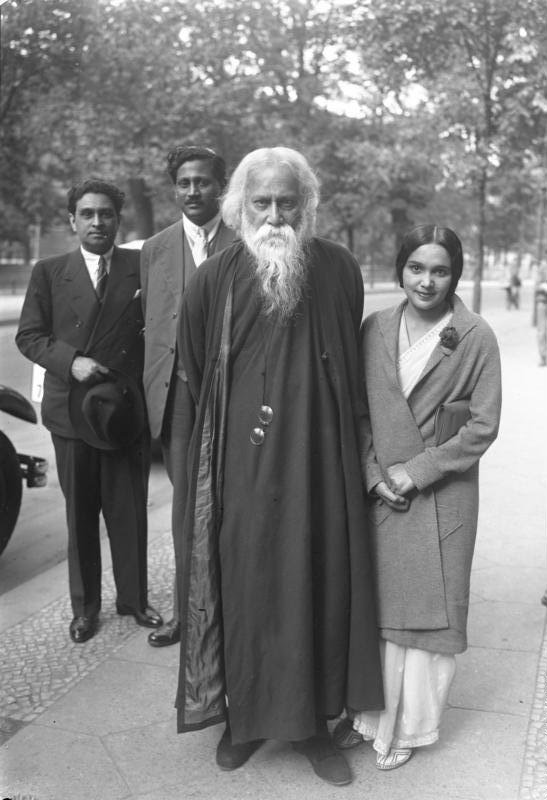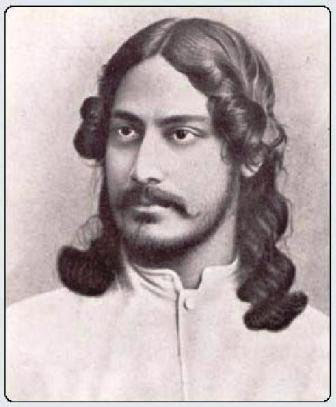Rabindranath Tagore

7 May: RT born in Calcutta into a wealthy and prominent family. His father was Maharishi Debendranath Tagore, a religious reformer and scholar. His mother, Sarada Devi, died when Tagore was very young - he realized that she would never come back was when her body was carried through a gate to a place where it was burned. Tagore's grandfather had established a huge financial empire for himself. He helped a number of public projects, such as Calcutta Medical College.
RT starts to compose poems.
RT's first book, a collection of poems, appears; it is published by Tagore's friend who wanted to surprise him.
Goes to England for college. Studies law at University College, London, but leaves after a year.
Marries Mrinalini Devi Raichaudhuri.
Mansi, a collection of Tagore's poems, is published
Settles at Shilaidaha in Kushthia (now in Bangladesh).
Writes seven volumes of poetry, all in Bengali.
Founds school outside Calcutta, Visva-Bharati, which was dedicated to emerging Western and Indian philosophy and education. It becomes a university in 1921.
RT's wife, father, daughter Renuka and son Samindra die.
Bengal is partitioned. Indians viewed the partition as an attempt by the British to disrupt the growing national movement in Bengal and divide the Hindus and Muslims of the region. The partition outraged Bengalis. Not only had the government failed to consult Indian public opinion, but the action appeared to reflect the British resolve to divide and rule. Widespread agitation ensued in the streets and in the press, and the Congress advocated boycotting British products.
WritesGitanjali in Bengali.
Writes "Jana Gana Mana," which later becomes Bangladesh's National Anthem
Gitanjali published in English. He misplaces the manuscript in the London Underground but it miraculously turns up in the lost and found section.

Awarded the Nobel Prize in Literature.
Knighted by King George.
The first Satyagraha Movements, inspired by Mohandas Gandhi, begin in Bihar and Gujarat.
Satyagraha, a term coined by Gandhi, can be loosely translated as "insistence on truth" (satya "truth"; agraha "insistence" or "holding firmly to") or "holding onto truth" or "truth force." It is a particular form of nonviolent resistance or civil resistance. The essence of the Satyagraha Movement is to fight against injustice, offering resistance without any hatred or injury to the opponent, in order to instill in him a sense of justice and win his heart without hurting him.
The forms of Satyagraha:
- Non-cooperation:
Strikes, boycotts, resignations from different offices, rejection of honorary degrees etc. - Civil disobedience:
The most powerful and extreme form of Satyagraha. The most popular ones are non-payment of taxes, disobedience to the state authority in its day-to-day activities, violation of laws and ordinances of the state. This is all done without the use of force. - Fasting:
Think hunger strikes. The extreme form of fasting is fasting until death. It garners international attention, but is a drastic maneuver. This has been called the “sharpest weapon in the arsenal of the disarmed.” - Constructive programs:
According to Gandhi, a civil disobedience movement is like to be powerless without the proper adoption and implementation of constructive programs taken at a particular point of time. This is the positive aspect of Satyagraha.
RT renounces his knighthood following the Jallianwala massacre incident.
On April 13, 1919, in the northern Indian city of Amritsar, British Indian Army soldiers started shooting an unarmed gathering of men, women and children who had assembled to participate in the annual Baisakhi celebrations—both a religious and cultural festival for the Punjabis. According to official British Raj sources, 379 people were killed. According to other sources, there were over 1,000 deaths, with more than 2,000 wounded, and Civil Surgeon Dr. Smith said that there were 1,526 casualties.
Takes up painting.
12 March: The Salt March begins.
Also known as the Dandi March and the Salt Satyagraha, this was an act of nonviolent civil disobedience initiated by Gandhi to produce salt from seawater, as was the practice of the local populace until British officials introduced taxation on salt production, deemed their sea-salt reclamation activities illegal, and then repeatedly used force to stop it. The 24-day march was a direct action campaign of tax resistance and nonviolent protest against the British salt monopoly, and it gained worldwide attention, which gave impetus to the Indian independence movement and started the nationwide Civil Disobedience Movement.
RT asks Gandhiji to lift the ban on Subhash Chandra Bose and have his cooperation cordially invited in the "supreme interest of national unity."
7 August: RT dies in Calcutta, India.